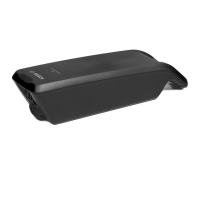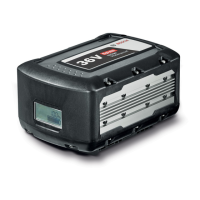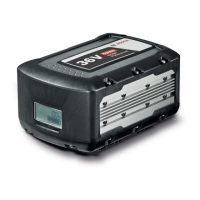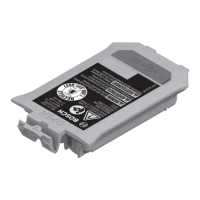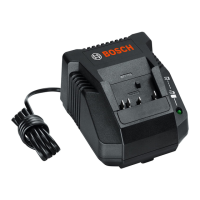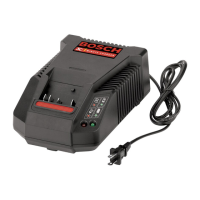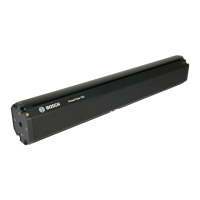
Do you have a question about the Bosch PowerTube 750 Series and is the answer not in the manual?
| Capacity | 750 Wh |
|---|---|
| Voltage | 36 V |
| Compatibility | Bosch eBike systems |
| Category | E-Bike Battery |
| Model | PowerTube 750 |
Usage of lithium-ion batteries in smartphones, cordless screwdrivers, electric cars, and eBikes.
Explanation of electromotive force generation by lithium-ion batteries and ion balance.
Details on the composition of eBike batteries, including cell count and volume comparison.
Comparison of eBike battery charging costs versus car fuel costs.
Information on the distance an eBike battery can cover in its lifetime.
Discussion on the recycling of used eBike batteries and material recovery.
Reasons why Bosch eBike batteries are popular, including features and advantages.
Lithium-ion batteries can be charged anytime without affecting capacity.
Batteries retain charge even after long storage periods, ideal for winter.
Intelligent BMS protects cells, extending battery lifespan for many trips and years.
Bosch chargers offer various performance levels for quick charging needs.
Batteries can be easily removed for convenient charging and storage away from the bike.
Economical drive solution, with low charging costs (e.g., 6 cents for a PowerPack 500).
Well-protected batteries require little maintenance, with expert support available.
Complete eBike system certified to UL 2849 safety standard for peace of mind.
Sporty frame batteries (400/500) for optimal weight distribution.
Convenient rack batteries (400/500) for step-through models, freeing up space.
Stylish integrated batteries (400, 500, 625, 750 Wh) fitting specific eBike designs.
System for combining two batteries for up to 1,250 Wh of energy.
Lightweight and small charger, ideal for cyclists on the move.
Robust and functional all-rounder charger with balanced performance, size, and weight.
Compact and lightweight charger, ideal for on-the-go charging, e.g., PowerTube 750*.
Online tool to estimate typical eBike range under various parameters.
Description of different riding modes (Eco, Tour, Sport, etc.) and their impact on range.
Optimize efficiency by maintaining a cadence above 50 rpm.
Minimize total weight of bicycle and cargo for better range.
Frequent starts/stops are less economical than constant speed riding.
Correct gear shifting improves eBiking efficiency; use lower gears for starting/inclines.
Inflate tires to maximum permissible pressure to minimize rolling resistance.
Use indicator to monitor motor and adapt riding style for power consumption.
Decreasing temperatures temporarily reduce battery performance and range.
Instructions for charging batteries at home and on the road.
How to charge PowerPacks and PowerTubes directly on the eBike.
Procedure for removing and charging the battery if it cannot be charged on the eBike.
Step-by-step guide on how to safely remove Bosch eBike batteries from their mounts.
Step-by-step guide on how to safely insert Bosch eBike batteries into their mounts.
Description of PowerPack features for convenient insertion, removal, and carrying.
Details on PowerTube's partial ejection and safety mechanism for easier handling.
Recommendations for cleaning batteries and plug connections.
Guidance on storing batteries at room temperature with a 30-60% charge status.
Tips for using batteries in cold conditions, including storage and protective covers.
List of conditions that negatively impact battery lifespan, such as heat and deep discharge.
List of conditions that promote battery longevity, such as moderate temperatures and charge status.
Instructions for transporting eBikes and batteries securely inside a car.
Information on airline regulations regarding eBike battery transport and recommendations.
Guidelines for transporting eBikes and batteries on trains, including ticket requirements.
Policies for taking eBikes on public transport like light rail and long-distance buses.
Explanation of safety risks and warranty voiding associated with battery repair.
Proper disposal of end-of-life batteries through local dealers for resource recovery.
Manufacturer's responsibility for recycling and importer's role across borders.
Information on the high efficiency of modern recycling processes for raw material recovery.
Note that batteries are designed and certified only for eBike use.
Description of the battery's internal protection features and avoidance of physical damage.
Guidelines for safe charging practices, using Bosch chargers and avoiding hazardous conditions.
Recommendations for safe battery storage, avoiding extreme temperatures and direct sunlight.
How dealers can check battery status and charging cycles using diagnostic tools.
Proper cleaning methods for batteries, using a damp cloth and avoiding water jets.
Correct procedures for disposing of used or defective batteries, not in household waste.
Guidance on dealing with water ingress in the battery mount and contact maintenance.
Precautions for handling and disposing of damaged batteries due to potential electrolyte leakage.
Emphasis on using original Bosch spare parts for safety, reliability, and efficiency.
Risks of using non-Bosch chargers, which may reduce battery life or cause malfunctions.
Warnings about using used batteries, including potential safety risks and legal issues.
Standardized test method for comparing eBike range and performance objectively.
Explanation of the R200 method's standardized conditions for transparent comparison.
How the R200 test provides specific range indications for comparing eBikes.


